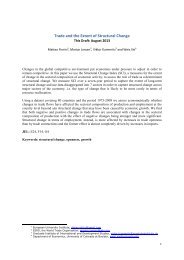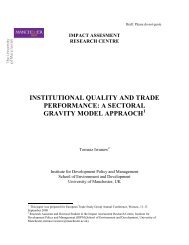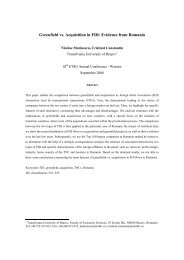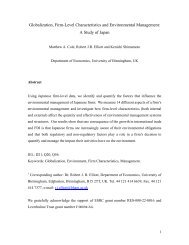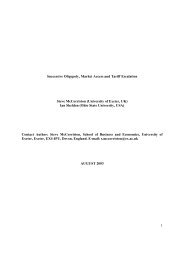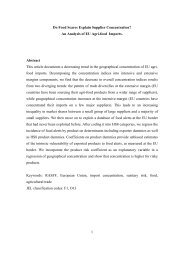Regional integration and the other determinants of North-South ...
Regional integration and the other determinants of North-South ...
Regional integration and the other determinants of North-South ...
You also want an ePaper? Increase the reach of your titles
YUMPU automatically turns print PDFs into web optimized ePapers that Google loves.
produces <strong>the</strong> most efficient <strong>and</strong> <strong>the</strong> least biased estimators if compared with <strong>the</strong> r<strong>and</strong>om<br />
effects model (Plümper <strong>and</strong> Troeger, 2007). The estimator decomposes <strong>the</strong> unit fixed effects<br />
into an unexplained part <strong>and</strong> a part explained by <strong>the</strong> time-invariant variables. In a first step, a<br />
fixed effects model is obtained to estimate <strong>the</strong> unit effects. The second step involves an<br />
ordinary least squared (OLS) regression <strong>of</strong> <strong>the</strong> fixed effects vector on <strong>the</strong> time invariant<br />
variables. This permits us to decompose <strong>the</strong> fixed effects vector into a part explained by <strong>the</strong><br />
time-invariant variables <strong>and</strong> an unexplainable part, <strong>the</strong> error term. In <strong>the</strong> last stage, <strong>the</strong> model<br />
is re-estimated by pooled OLS, including all explanatory variables, <strong>the</strong> time-invariant<br />
variables <strong>and</strong> <strong>the</strong> error term. This model is presented in column (3) 44 . Finally, in order to<br />
tackle <strong>the</strong> problem <strong>of</strong> <strong>the</strong> correlation between <strong>the</strong> residuals <strong>and</strong> some independent<br />
variables (GDPs), both two stage least squares instrumental variable model (2SLS IV) <strong>and</strong><br />
Arrelano, Bond <strong>and</strong> Bover’s GMM estimator have been implemented 45 .<br />
Estimation results<br />
[Table 4.1]<br />
The models fit <strong>of</strong> <strong>the</strong> regression is in line with <strong>the</strong> usual finding in gravity literature.<br />
All <strong>the</strong> parameters are significant at <strong>the</strong> 5% level <strong>and</strong> present <strong>the</strong> expected sign: an increase <strong>of</strong><br />
importer <strong>and</strong> exporter’s GDP increases trade flows. The distance between countries <strong>and</strong> <strong>the</strong><br />
presence <strong>of</strong> borders strongly affect trade. The parameter distance is more than <strong>the</strong> unity <strong>and</strong><br />
<strong>the</strong> intra-trade is, on average, 11 times (=exp(2,42)) larger than <strong>the</strong> cross-border trade in <strong>the</strong><br />
euro-Mediterranean area.<br />
Since bilateral trade barriers vary across countries, <strong>the</strong> average border effect can mask<br />
substantial differences across country groups. In o<strong>the</strong>r to check for <strong>the</strong>se differences, in a<br />
second stage, we break down <strong>the</strong> sample into three country groups: 12 Western European<br />
Countries (WEC), 10 new member states (NMS) <strong>and</strong> 6 Mediterranean countries (MC).<br />
Consequently, border effects have been re-evaluated for each group separately (Table 4.2) 46 .<br />
We can notice that <strong>the</strong> WEC border effect is relatively low in comparison to both NMS <strong>and</strong><br />
MC border effects. Crossing <strong>the</strong> national frontier inside <strong>the</strong> WEC reduces trade by 4.5 times<br />
(exp(1.50)), whereas it generates a decrease <strong>of</strong> trade by a factor <strong>of</strong> 7 in <strong>the</strong> NE group <strong>and</strong> 244<br />
in <strong>the</strong> MED group. This result clearly shows <strong>the</strong> lack <strong>integration</strong> between Mediterranean<br />
countries <strong>and</strong> tends to confirm Almonte <strong>and</strong> Gualiano’s (2003) results: Eastern Europe is<br />
more integrated than Mediterranean countries. This non-existence <strong>of</strong> an important<br />
“Mediterranean” market could have an important impact on firm’s location choices. Eastern<br />
countries can be more attractive than Mediterranean countries because <strong>of</strong> both <strong>the</strong>ir proximity<br />
to <strong>the</strong> WEC markets <strong>and</strong> <strong>the</strong> relatively less segmented regional market 47 .<br />
44 Even if we have a few zero values (0,38%) in our dataset, we have also tried to estimate <strong>the</strong> equation using<br />
<strong>the</strong> Poisson Pseudo-Maximum Likelihood (PPML) estimator. However, Poisson iterations have not converged.<br />
45 Note that ano<strong>the</strong>r solution would have been to transfer <strong>the</strong> GDPs to <strong>the</strong> left <strong>of</strong> <strong>the</strong> equation.<br />
46 For space raisons, we only present two models in tables 4.2.<br />
47 Note that <strong>the</strong> market accessibilities measured here include <strong>the</strong> access for both industrial <strong>and</strong> agricultural goods<br />
<strong>and</strong> are so a bit overestimated. That could partly explain <strong>the</strong> very high border effects concerning Mediterranean<br />
countries.<br />
15



